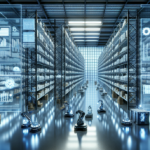Understanding the Importance of Efficient Warehouse and Shipping Processes
Efficient warehouse and shipping processes are vital for businesses aiming to transport their products seamlessly from manufacturing facilities to customers. Streamlined operations ensure timely delivery, reduced labor costs, minimized errors, and enhanced customer satisfaction. According to a Statista report, automated warehouse solutions can increase operational efficiency by up to 50%.
Common Challenges in Warehouse and Shipping Operations
Even with optimized systems, warehouses and shipping departments encounter several challenges that can hinder efficiency and increase costs:
- Inventory Inaccuracies: Mismanaged stock levels can lead to overstocking or stockouts, affecting order fulfillment.
- Reliance on Manual Processes: Paper-based systems are prone to errors and can slow down operations.
- Inadequate Staffing: Understaffing can lead to delays and increased pressure on employees, resulting in mistakes.
- Poor Communication: Lack of coordination between departments can cause misunderstandings and operational inefficiencies.
- Limited Supply Chain Visibility: Without real-time tracking, organizations may face delays and difficulties in order tracking.
Strategies to Optimize Warehouse and Shipping Processes
Implementing Lean Principles
Adopting Lean principles focuses on eliminating waste, streamlining operations, and fostering a culture of continuous improvement. This approach can:
- Reduce lead times by eliminating unnecessary steps.
- Decrease defects and errors in shipments.
- Optimize inventory levels, minimizing holding costs.
Lean methodologies not only enhance efficiency but also boost employee morale by involving them in process improvements.
Utilizing Advanced Technology
Integrating technology is crucial for modernizing warehouse and shipping operations. Key technologies include:
- Barcode and RFID Systems: Improve inventory tracking accuracy and reduce the likelihood of lost or misplaced items.
- Warehouse Management Systems (WMS): Provide real-time data on inventory levels, order statuses, and workflow efficiencies.
- Automation and Robotics: Enhance speed and precision in tasks such as picking, packing, and sorting.
- Drones and IoT Devices: Facilitate inventory checks and real-time monitoring of stock levels.
According to a McKinsey report, automation can improve warehouse productivity by 20-60% while reducing operational costs.
Best Practices for Inventory Management
Effective inventory management ensures that businesses can meet customer demand without overstocking. Best practices include:
- Real-Time Tracking: Utilize WMS and RFID technology to maintain accurate inventory records.
- Demand Forecasting: Analyze historical sales data to predict future demand and adjust inventory levels accordingly.
- Regular Audits: Conduct periodic inventory checks to identify and rectify discrepancies.
- Automated Reordering: Implement systems that trigger reorders when stock levels fall below predefined thresholds.
Cost Reduction in Warehouse and Shipping Operations
Reducing costs without compromising efficiency is essential for profitability. Strategies to achieve this include:
Outsourcing Non-Core Activities
Outsourcing tasks such as packaging or transportation can reduce overhead costs and allow businesses to focus on their core competencies.
Optimizing Operational Workflows
Streamlining processes to eliminate redundancies and enhance workflow can lead to significant cost savings. Implementing Lean principles and utilizing automation are effective methods.
Investing in Automation
While the initial investment may be high, automation technologies can reduce labor costs and increase operational efficiency in the long run.
Implementing Lean Inventory Management Systems
Adopting a lean inventory system ensures that businesses maintain optimal stock levels, reducing storage costs and minimizing the risk of product obsolescence. This approach involves closely monitoring inventory and ordering only what is necessary to fulfill customer orders.
Enhancing Efficiency through Time Management and Quality Control
Maximizing Time Management
Efficient time management is critical for reducing lead times and ensuring timely deliveries. Tools and techniques include:
- Workload Mapping: Identify and allocate resources effectively across different tasks.
- Time Tracking Applications: Monitor the time spent on various operations to identify bottlenecks.
- Process Flow Charts: Visualize workflows to streamline operations and eliminate unnecessary steps.
Ensuring Quality Control
Maintaining high-quality standards is essential for customer satisfaction and reducing returns. Best practices include:
- Continuous Training: Regularly train employees on quality standards and best practices.
- Monitoring Tools: Utilize software and automated systems to track quality metrics.
- Setting Clear Standards: Establish and communicate quality control benchmarks to all team members.
Safety and Employee Training in Warehouse Operations
Implementing Safety Measures
Ensuring a safe working environment is paramount. Steps to enhance safety include:
- Risk Management Plans: Develop and integrate comprehensive risk assessments into daily operations.
- Regular Inspections: Conduct frequent safety audits to identify and mitigate potential hazards.
- Safety Equipment Policies: Enforce the use of appropriate safety gear and equipment.
Training Employees for Efficiency
Employee training is crucial for maintaining high operational standards. Effective training programs should cover:
- Lean Principles: Educate employees on waste reduction and process optimization techniques.
- Equipment Operation: Provide hands-on training for operating machinery and automated systems safely.
- Quality Control Protocols: Ensure employees understand and adhere to quality standards.
Offering incentives and recognition can further motivate employees to maintain high performance and contribute to continuous improvement.
Measuring Performance Metrics for Continuous Improvement
Tracking key performance indicators (KPIs) is essential for assessing the effectiveness of warehouse and shipping operations. Important KPIs include:
- Order Fulfillment Time: Measures the average time taken to process and deliver orders.
- Inventory Turnover Rate: Indicates how quickly inventory is sold and replaced over a specific period.
- Shipping Accuracy: Tracks the percentage of orders shipped correctly without errors.
- Cost per Order: Calculates the total cost associated with processing each order.
Regularly analyzing these metrics allows organizations to identify trends, address inefficiencies, and make data-driven decisions to enhance overall performance.
Managing Returns in Warehousing and Shipping Operations
Effective returns management is essential for maintaining inventory accuracy and customer satisfaction. Key strategies include:
- Clear Return Policies: Establish and communicate straightforward return procedures to customers.
- Efficient Processing: Implement systems to quickly process returns, inspect products, and restock or dispose of items as necessary.
- Inventory Updates: Ensure that returned items are accurately reflected in inventory systems to maintain precise stock levels.
- Customer Service: Provide responsive support to address return inquiries and resolve issues promptly.
The Future of Warehousing and Shipping: Trends and Innovations
Technological advancements continue to shape the future of warehouse and shipping operations. Emerging trends include:
- Robotics and Automation: Increasing use of robots for tasks such as picking, packing, and sorting to enhance speed and accuracy.
- Artificial Intelligence (AI): Leveraging AI for predictive analytics, demand forecasting, and optimizing supply chain decisions.
- Internet of Things (IoT): Implementing IoT devices for real-time monitoring of inventory, equipment, and environmental conditions.
- Autonomous Vehicles: Deployment of self-driving trucks and drones for more efficient and cost-effective transportation.
- Blockchain Technology: Enhancing supply chain transparency and security through immutable record-keeping.
Staying abreast of these innovations allows businesses to remain competitive, improve operational efficiency, and meet evolving customer expectations.
Conclusion
Efficient warehouse and shipping operations are critical to the success of any business involved in product distribution. By implementing Lean principles, utilizing advanced technologies, managing inventory effectively, reducing costs, ensuring quality and safety, and staying informed about future trends, organizations can significantly enhance their operational efficiency. Monitoring key performance metrics and fostering a culture of continuous improvement further contribute to sustained success and heightened customer satisfaction.




















